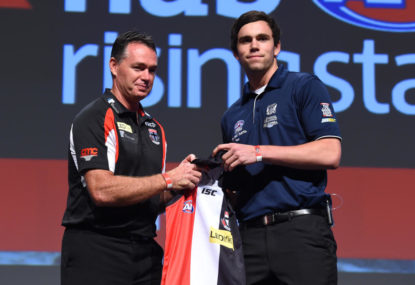'Sucked in beautifully': Neale, Lions goaded into two off-ball frees, then tries to win one himself
Things heating up in Canberra!

They aren’t known for their patience, and AFL pundits have once again been caught out in recent weeks engaging in premature groupthink regarding the development and talent of some of the game’s emerging young key position talents.
It’s a well-worn footy adage that key forwards take time to develop, but just for the moment, large sections of the punditry seem to have forgotten that.
This criticism is nothing new, and it’s been growing steadily over the past decade – the AFL public’s insatiable appetite for immediate success has led to criticism of young, developing key forwards becoming harsher than ever.
This is particularly the case for those who enter the competition as high draft picks or father-son selections, with fans expecting them to have an instant impact and become stars of the competition in their first few years.
Four such players – Brisbane’s Josh Schache, Collingwood’s Darcy Moore, St Kilda’s Paddy McCartin and the Western Bulldogs’ Tom Boyd – have been the most recent to feel the heat.
Public perception is that Schache’s and Moore’s impacts have fallen away this year (indeed, such is the assessment of Moore’s form that, after the Pies’ Anzac Day loss to Essendon, commentators called for him to be played in defence to regain some confidence), while Boyd has had an inconsistent start to follow a breakout 2016 finals campaign. McCartin, too, has felt the heat for two performances in which he was quiet and failed to make an impact.

This criticism is premature and lacks foresight, and we should all take a step back and temper our expectations. These four players are all aged under 22 and have all played four seasons or less.
History shows that key forwards take around five years to really develop and fulfil their potential to the point where they are having a consistent impact each week. Past champions Jonathan Brown, Alastair Lynch and Matthew Pavlich all fit this mould, as does current Geelong star Tom Hawkins, but more on him a bit later.
All four players are on par with their predecessors in averaging around 1-1.5 goals a game at this point in their careers.
For Moore and Schache, who have often been relied upon as their team’s sole tall target inside 50, this is a tremendous effort. Before Travis Cloke’s recruitment at the end of last season, Boyd, too, was also more often than not the Dogs’ primary key forward target.
Schache and Boyd have dropped off slightly in their contested mark counts (Schache has none so far for the year after 21 last year, while Boyd has one so far after 18 last year) but Moore and McCartin are nearly identical to 2016. Disposal-wise, all four are averaging similar numbers to last year. Hardly cause for concern.
It’s the perceived drop-off in on-field impact that has led to the criticism, but this too has largely failed to take into account other circumstances.
Moore has struggled with the terrible delivery into the Pies’ forward line, both with the placement and execution of delivery, with Collingwood going at only 50 per cent success rate on inside 50 delivery.
The Pies have tried both Mason Cox and Jesse White has forward targets alongside Moore, but the youngster has remained the key focal point, and with few other foils, has drawn the opposition’s best defender each week.
Having Travis Cloke alongside him at times last year gave Moore greater freedom and allowed him to be much more impactful.
Likewise, Schache has been a victim of Brisbane’s poor execution. However, the emergence of fellow second-year forward Eric Hipwood as an alternative has also played a role, with Hipwood becoming the primary target, averaging 1.7 marks inside 50 and 1.2 contested marks and 1.8 goals per game.
While this has seen Schache’s goal output drop slightly, averaging 1.0 this season, it has given him the freedom to contribute in other ways, which is borne out in the figures – he’s averaging 0.8 goal assists (up from 0.4 in 2016), and is on track to equal his average of 4.4 score involvements per game (currently 3.5).
It could be argued that McCartin, too, has suffered from not being the Saints’ main forward target, with Josh Bruce and Tim Membrey being ahead of him in the pecking order.
McCartin has also missed numerous games through concussion, having suffered several over the past few years.
Criticism of McCartin has been such that some commentators have questioned the Saints’ decision to take him over Christian Petracca in the 2014 draft – not only is this incredibly premature, but it disregards the Saints’ list profile at the time, which was in desperately need of a key forward to replace Nick Riewoldt.
The criticism of Boyd has been most fierce, given his large price tag and his seeming breakout game in last year’s grand final.
He has been less impactful on the scoreboard and has amassed fewer disposals so far this season, but has contributed in other ways, including taking most of the ruck duties due to injuries to Jack Redpath, Tom Campbell and Jordan Roughead. Travis Cloke’s arrival means Boyd is no longer the main target when he does play forward.

All of this could be looked at as an example of history repeating itself. Tom Hawkins arrived at Geelong as a father-son selection in the 2006 draft, and over the first five years of his career, including Geelong’s premiership years of 2007, 2009 and 2011, averaged around 1.5 goals a game.
In his first two seasons, he played nine and ten games respectively, but in the next three he played close to every game. Big things were expected of him, but in the public’s eye he failed to deliver and was criticised for his lack of endurance and agility.
It took until the 2011 grand final for Hawkins to come of age – with fellow key forward James Podsiadly injured, Hawkins was left as the team’s sole key forward, and his three crucial goals turned the game the Cats’ way.
After the game, Hawkins’ father credited a positional change – from ruck/forward to full-time key forward – and time in the VFL as the catalyst for his son’s new-found form.
Hawkins continued this form into 2012 and has since become one of the game’s dominant forwards. In that year, he kicked 62 goals and had more disposals than he had in his career to date. Since then, he has averaged around 2.5 goals per game, kicking 68 in 2014 and 55 last season.
Of course, it’s still too early to categorically state that all four of these young forwards will develop into champion players like Hawkins, Brown, Lynch and Pavlich, but all are on the same trajectory at the same stage of their careers.
The public and media alike have short memories in this regard. Let’s suspend judgement until they’ve played at least five seasons, and remember the simple truth that good things take time.